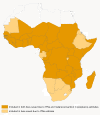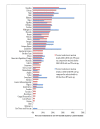Estimates of child deaths prevented from malaria prevention scale-up in Africa 2001-2010
- PMID: 22455864
- PMCID: PMC3350413
- DOI: 10.1186/1475-2875-11-93
Estimates of child deaths prevented from malaria prevention scale-up in Africa 2001-2010
Abstract
Background: Funding from external agencies for malaria control in Africa has increased dramatically over the past decade resulting in substantial increases in population coverage by effective malaria prevention interventions. This unprecedented effort to scale-up malaria interventions is likely improving child survival and will likely contribute to meeting Millennium Development Goal (MDG) 4 to reduce the < 5 mortality rate by two thirds between 1990 and 2015.
Methods: The Lives Saved Tool (LiST) model was used to quantify the likely impact that malaria prevention intervention scale-up has had on malaria mortality over the past decade (2001-2010) across 43 malaria endemic countries in sub-Saharan African. The likely impact of ITNs and malaria prevention interventions in pregnancy (intermittent preventive treatment [IPTp] and ITNs used during pregnancy) over this period was assessed.
Results: The LiST model conservatively estimates that malaria prevention intervention scale-up over the past decade has prevented 842,800 (uncertainty: 562,800-1,364,645) child deaths due to malaria across 43 malaria-endemic countries in Africa, compared to a baseline of the year 2000. Over the entire decade, this represents an 8.2% decrease in the number of malaria-caused child deaths that would have occurred over this period had malaria prevention coverage remained unchanged since 2000. The biggest impact occurred in 2010 with a 24.4% decrease in malaria-caused child deaths compared to what would have happened had malaria prevention interventions not been scaled-up beyond 2000 coverage levels. ITNs accounted for 99% of the lives saved.
Conclusions: The results suggest that funding for malaria prevention in Africa over the past decade has had a substantial impact on decreasing child deaths due to malaria. Rapidly achieving and then maintaining universal coverage of these interventions should be an urgent priority for malaria control programmes in the future. Successful scale-up in many African countries will likely contribute substantially to meeting MDG 4, as well as succeed in meeting MDG 6 (Target 1) to halt and reverse malaria incidence by 2015.
Figures





References
-
- Black RE, Cousens S, Johnson HL, Lawn JE, Rudan I, Bassani DG, Jha P, Campbell H, Walker CF, Cibulskis R, Eisele T, Liu L, Mathers C. Global, regional, and national causes of child mortality in 2008: a systematic analysis. Lancet. 2010;375:1969–1987. doi: 10.1016/S0140-6736(10)60549-1. - DOI - PubMed
-
- Lengeler C. Insecticide-treated bed nets and curtains for preventing malaria. Cochrane Database Syst Rev. 2004;2:CD000363. - PubMed
-
- Garner P, Gulmezoglu AM. Drugs for preventing malaria in pregnant women. Cochrane Database Syst Rev. 2006;4:CD000169. - PubMed
-
- ter Kuile FO, Terlouw DJ, Phillips-Howard PA, Hawley WA, Friedman JF, Kariuki SK, Shi YP, Kolczak MS, Lal AA, Vulule JM, Nahlen BL. Reduction of malaria during pregnancy by permethrin-treated bed nets in an area of intense perennial malaria transmission in western Kenya. Am J Trop Med Hyg. 2003;68:50–60. - PubMed
MeSH terms
Substances
LinkOut - more resources
Full Text Sources
Medical
Miscellaneous

